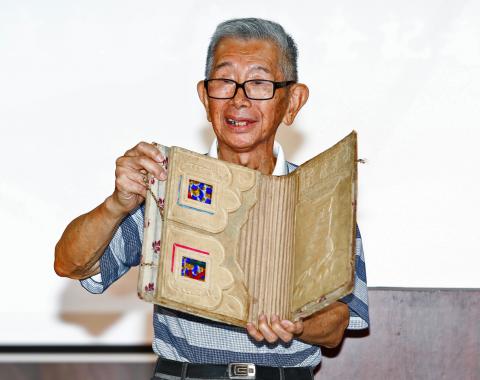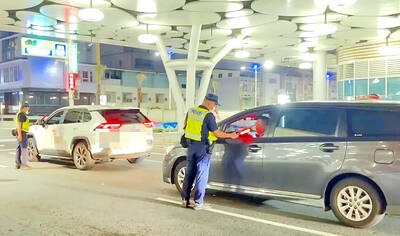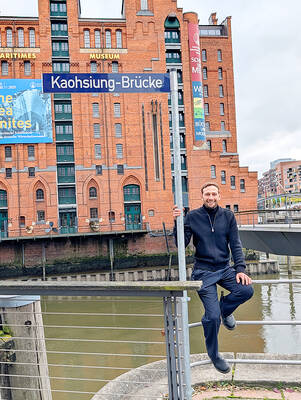Hsu Kui-piao (許貴標), 82, recently donated a papier-mache scrapbook that seemed like an ordinary item at first glance. However, Hsu’s gift embodied the persecution and sacrifice suffered by Taiwanese during the White Terror era and the remarkable friendship among condemned political prisoners.
“This is the 55th year since I was released from prison. I have the good fortune to share my story here, but my heart is stirred up with strong emotions,” Hsu said as he presented the book to the Preparatory Office of the National Human Rights Museum on Tuesday last week.
The former prisoner said that informants falsely accused him of “failing to report known Communist spy activities to the authorities” in 1954, which led to a seven-year jail sentence.

Photo: Wang Yi-sung, Taipei Times
The White Terror era refers to the Chinese Nationalist Party (KMT) regime’s persecution of political dissidents in Taiwan for nearly four decades until the lifting of martial law in 1987.
Hsu said the papier-mache book was made by two fellow prisoners, Wu Peng-tsan (吳鵬燦) and Lien Te-en (連德恩), when they were incarcerated at the military prison on Qingdao E Road in Taipei. The Taipei Sheraton Hotel now occupies the site.
Locked up on sedition charges, Wu and Lien understood that they had little chance of coming out alive, given that death sentences were meted out for sedition during the Martial Law era. Seeing that Hsu had the chance to be freed after serving his sentence, Wu and Lien decided to dedicate a gift to him, Hsu said.
With stones and empty cans collected during their brief times in the prison courtyard, the two condemned political prisoners secretly made small razors.
Using the razors and other improvised tools, they made papier-mache materials by cutting up packaging papers from parcels and clothing items given by family members during prison visits. The glue was made by soaking rice from leftover meals in water, Hsu said.
Wu and Lien made the book in secret and under difficult conditions, away from the prying eyes of the prison wardens who were on regular patrols, Hsu said.
“It took them three months to finish. With painstaking efforts, they embossed my name on it, along with an embossed picture of a ship sailing out on the sea,” Hsu said.
“Each time that I see this sailing ship, my mind always contemplates whether my two friends were giving me their blessing to sail on with success in my endeavors after getting out of prison, or whether they wanted to express the feeling that ‘We are bound by fate on the same ship?’” he said.
Not long after Wu and Lien completed their task and presented the book to Hsu, they were executed.
“With my own eyes, I saw Wu and Lien being marched out by guards, taken away to be executed. I could only watch and bid farewell to my friends with streams of tears,” Hsu said, choked with emotion.
Hsu stressed that “our democracy and freedom were won with the lives, blood and tears of many who went before us.”
“This ordinary-looking book is soaked with the blood and sacrifice of two outstanding young men. It is an eyewitness to the horrible atrocities of White Terror era,” Hsu said. “It is my hope that all 23 million Taiwanese can truly live in a free and democratic society.”
The papier-mache book had always been Hsu’s most treasured possession, where he kept the original indictment papers and the court ruling documents on his case.
Hsu said he decided to donate it “so Taiwanese can preserve the memories of the White Terror era and it will not be forgotten through the passage of time.”

TRAFFIC SAFETY RULES: A positive result in a drug test would result in a two-year license suspension for the driver and vehicle, and a fine of up to NT$180,000 The Ministry of Transportation and Communications is to authorize police to conduct roadside saliva tests by the end of the year to deter people from driving while under the influence of narcotics, it said yesterday. The ministry last month unveiled a draft of amended regulations governing traffic safety rules and penalties, which included provisions empowering police to conduct mandatory saliva tests on drivers. While currently rules authorize police to use oral fluid testing kits for signs of drug use, they do not establish penalties for noncompliance or operating procedures for officers to follow, the ministry said. The proposed changes to the regulations require

The Executive Yuan yesterday announced that registration for a one-time universal NT$10,000 cash handout to help people in Taiwan survive US tariffs and inflation would start on Nov. 5, with payouts available as early as Nov. 12. Who is eligible for the handout? Registered Taiwanese nationals are eligible, including those born in Taiwan before April 30 next year with a birth certificate. Non-registered nationals with residence permits, foreign permanent residents and foreign spouses of Taiwanese citizens with residence permits also qualify for the handouts. For people who meet the eligibility requirements, but passed away between yesterday and April 30 next year, surviving family members

Taiwanese officials are courting podcasters and influencers aligned with US President Donald Trump as they grow more worried the US leader could undermine Taiwanese interests in talks with China, people familiar with the matter said. Trump has said Taiwan would likely be on the agenda when he is expected to meet Chinese President Xi Jinping (習近平) next week in a bid to resolve persistent trade tensions. China has asked the White House to officially declare it “opposes” Taiwanese independence, Bloomberg reported last month, a concession that would mark a major diplomatic win for Beijing. President William Lai (賴清德) and his top officials

The German city of Hamburg on Oct. 14 named a bridge “Kaohsiung-Brucke” after the Taiwanese city of Kaohsiung. The footbridge, formerly known as F566, is to the east of the Speicherstadt, the world’s largest warehouse district, and connects the Dar-es-Salaam-Platz to the Brooktorpromenade near the Port of Hamburg on the Elbe River. Timo Fischer, a Free Democratic Party member of the Hamburg-Mitte District Assembly, in May last year proposed the name change with support from members of the Social Democratic Party and the Christian Democratic Union. Kaohsiung and Hamburg in 1999 inked a sister city agreement, but despite more than a quarter-century of